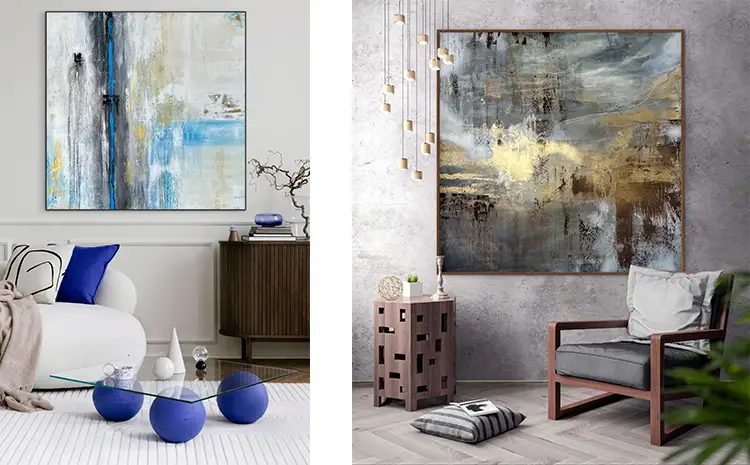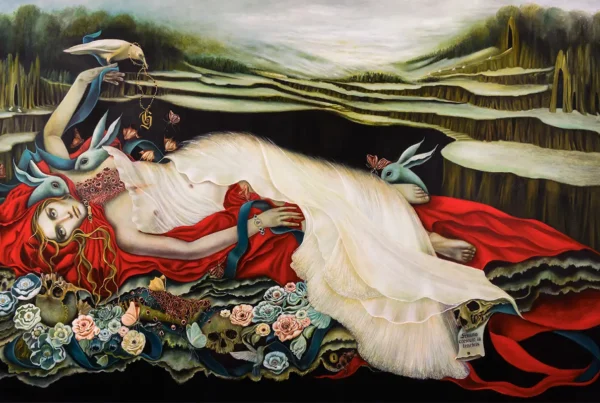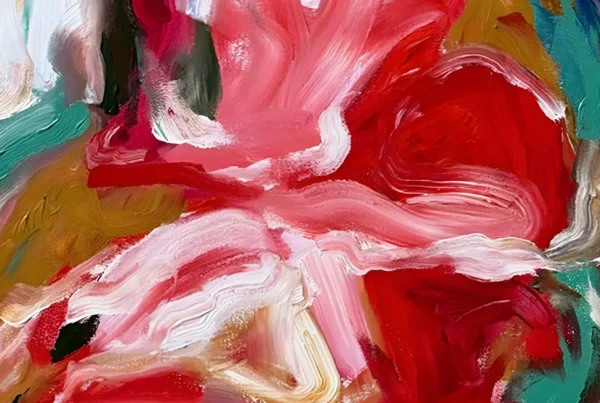“I create art for burning minds and souls that forgot how to breathe.”
From Boardroom to Brushstroke: A Journey Redrawn
In a world where titles, deadlines, and achievements often dictate identity, Birutė Celik made an unexpected and transformative departure. Once a high-ranking executive navigating the intensity of global business, she now crafts artworks that embrace vulnerability, rhythm, and emotion. Her previous life, marked by strategic leadership in international tourism and aviation, formed a duality she now explores in paint: a disciplined mind seeking freedom, and a structured life yearning for spontaneity. The shift was not so much a rejection of her past but a reimagining of its core elements through art. Where spreadsheets once lay, now lie layers of acrylic, charcoal, and textured paste.
Celik’s abstract compositions do not simply display color and form; they pulse with lived experience. Her canvases echo the delicate tension between order and entropy, mirroring her corporate past and creative present. The rhythm of movement—whether in a jetliner’s trajectory or a brushstroke’s sweep—remains integral to her process. Traveling through continents in her earlier career imprinted her with a sensitivity to nuance, subtle shifts, and ephemeral beauty. This internal archive of places, people, and patterns resurfaces in every piece she creates.
Rather than positioning art as an escape, Celik regards it as a return: to stillness, to truth, and to the felt sense of the world. The discipline that once structured her boardroom life now serves her practice in the studio, where the chaos of creativity is harnessed, not controlled. Each layer of her work becomes a quiet rebellion against superficial perfection, favoring the raw, the uncertain, and the emotionally resonant. For Celik, painting is not a profession but a reawakening.
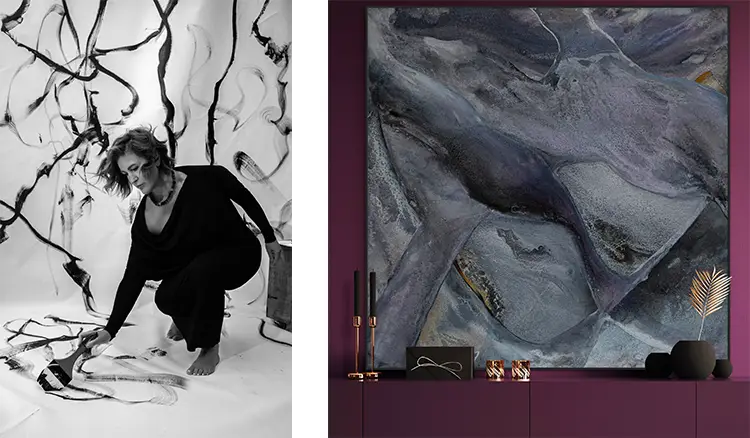
Birutė Celik
@Moonlight
Birutė Celik: Listening to Color, Breathing Through Texture
The artist’s journey into painting did not begin with formal training or academic frameworks, but with a conscious decision to listen more deeply—to silence, to intuition, and to the unspoken language of materials. Birutė Celik is entirely self-taught, drawing knowledge not from institutions but from her encounters with global cultures, art museums, and everyday emotional landscapes. What started as a solitary creative act soon evolved into an expressive practice with the power to move others. Her works now stand as invitations to pause, to exhale, and to connect with sensations that often get lost in the static of modern life.
Celik’s distinctive visual language is shaped by a tactile sensitivity and an emotional honesty. Working with a wide range of materials—acrylics, textured pastes, polymeric substances, gold leaf, and crayons—she builds surfaces that feel aged and immediate, eroded and alive. Transparency and density interact constantly, crafting a visual tension that mirrors her recurring themes: serenity battling turbulence, surrender meeting structure, and chaos negotiating with control. Her motto, that she creates for “burning minds and souls that forgot how to breathe,” reveals both her artistic purpose and her audience—those seeking refuge from overstimulation and disconnection.
Her art exists in a space between feeling and form, driven not by aesthetics alone but by sensation and presence. Rather than offering a literal image, she constructs a sensory landscape. The interplay between roughness and smoothness, silence and rhythm, draws viewers into an inner dialogue. Each mark she makes is both deliberate and instinctive, a product of practiced intuition. Through her work, Celik proposes a different way of perceiving: not through analysis, but through attunement.
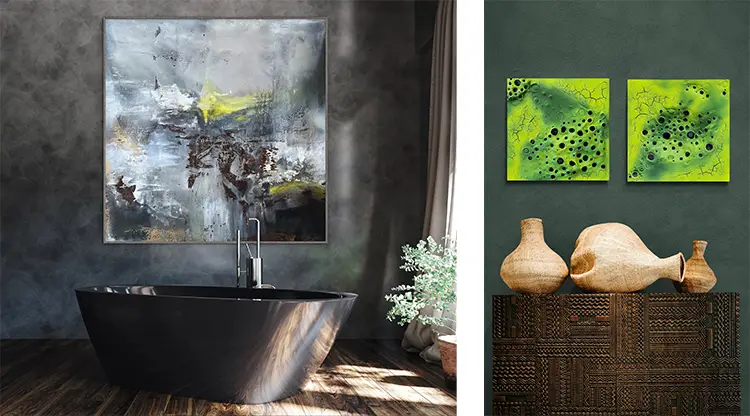
Mirage
In Fail We Trust
Weathered Walls and Whispering Dunes: Inspirations Etched in Memory
Birutė Celik’s creative fuel does not come primarily from art world trends or the canon of modern abstraction. Her deepest influences are instead found in fragments of daily life, distant landscapes, and the sensory impressions left behind by travel. Her connection to place is deeply visceral: a weathered Lisbon wall, the turquoise glint of a Mykonos sea, or the gentle hush of Baltic dunes all linger as silent collaborators in her work. These physical textures and atmospheres accumulate in her memory, later resurfacing through the movement of brush and hand.
She often cites the significance of rhythm, not only in terms of visual flow but in a sonic sense as well. Music becomes a co-creator in her studio, guiding her through spontaneous gestures or structured layering. The resulting visual pieces are imbued with a kind of pulse—at times meditative, at others urgent. While the works of artists like Rothko or Richter may sit in her visual memory, it is not mimicry but mood that Celik inherits from them. The emotive resonance of their pieces echoes in her commitment to emotional authenticity and atmospheric depth.
Life, in its unpredictable entirety, remains her most enduring teacher. The passage of time, the cycles of decay and renewal, the contradictions between fragility and resilience—all of these find physical form in her compositions. Celik’s work often suggests topographies shaped by internal weather systems, where memory is sediment and feeling is a force of erosion. Each painting is a layered response to the world, not as it appears, but as it is experienced—imperfect, luminous, and perpetually shifting.

Rust Does Not Rest
Within
Birutė Celik: The Diptych That Breathes in Silence
Among the many pieces in Birutė Celik’s evolving body of work, the diptych Sen and Sei holds particular personal and conceptual weight. Inspired by Japanese kanji, the two parts represent seemingly opposing yet intimately connected forces. Sen symbolizes motion, continuity, and the ever-forward momentum of life, while Sei embodies calm, stillness, and inner equilibrium. Together, the diptych forms not just an aesthetic statement but a philosophical reflection on how contrast shapes meaning. The duality between presence and passage is not resolved but embraced, echoing Celik’s broader thematic preoccupations.
The materials used to create Sen and Sei are as intentional as the themes they convey. Celik layered acrylic and oil paints with asphalt pigment, charcoal, crackled texture paste, and metallic gold elements. This fusion results in surfaces that feel ancient and alive, as though they had endured both harsh weather and sacred stillness. The cracked layers evoke the passage of time not as something lost, but as something embodied—imprinted within the material itself. The interplay between fragility and resilience is not merely visual but deeply tactile, inviting viewers to feel the tension and resolution with their eyes and their bodies.
Sen and Sei transcends the notion of a single artwork. It functions as a meditative site, a visual space where time slows and breath returns. Celik invites the observer into a shared moment of reflection, where silence is not emptiness but presence. The work exemplifies her ability to merge philosophical insight with raw physicality, positioning her practice as both an aesthetic and emotional experience. In a world often dominated by noise and speed, this diptych becomes a quiet but powerful call to notice, to feel, and to simply be.
